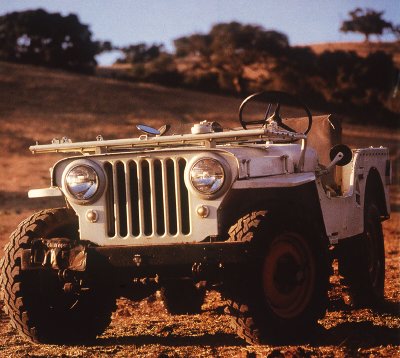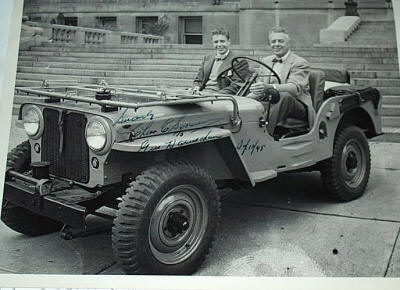Brief History of JEEP or Jeep Wrangler – another file of history!


“In 1908, John North Willys acquired the company Overland Automotive Indiana, which was located in
In 1912 was established the company Willys-Overland and the production started, besides the Runabout model, for the mass production car Willys Knight. In 1936, after the transformation suffered following the recession and the reorganization due to bankruptcy, Willys – Overland Motors Inc. was established.
In 1939, at the beginning of the Second World War, occurred the idea of building an universal military vehicle, as a need of the army to replace the vehicles owned. They were using simple and with side-car motorcycles from the first war and cars such as Ford T model modified, so the desired specifications were submitted to two constructors, as follows:
- 600 pounds (270 kg) payload;
- Maximum wheelbase 75 inches (1.9m);
- Height of up to 36 inches;
- Maximum speed 50mph (approximately 80km/h);
- Rectangular shaped body;
- 2-speed transfer box with 4X4 transmission;
- Folding windshield;
- 3 individual seats (no benches)
- Total weight less than 1,200 pounds (540kg).
137 companies have been invited to this project, but only 3 have managed to create this vehicle: Ford Motor Company, Willys-Overland and American Bantam Car.

In 1940, Willys Overland Motors Inv. Started to develop and manufacture the first
Jeep name has an interesting history, basically coming from the Ford model GP (GP=general purpose), which pronounced sounds like GIP =Jeep. Willys has immediately registered this brand and has acquired its ownership. However, there is another version of the origin of Jeep name, from a popular cartoon character of Popeye series, Eugen The Jeep.
Immediately after the World War II, Willys sensed the opportunity of a huge sales market for the civil version of Jeep Willys, as transport or recreational vehicle, but the entire production was designed at that time for the
The first civil model Jeep CJ 2A was produced in 1945 and was promoted as a work car for farmers and construction workers. As updates, were introduced: the back door, the side-mounted spare tire, larger headlights and the outside fuel cap, which were never found on the military models. CJ 2A was produced 4 years in a row and in 1948 CJ 3A was introduced. Very similar with the previous model, except for the one-piece windshield, keeping however the L Head 4-cylinder engine

The CJ model was perfected in 1953, becoming CJ-3B. It had a higher front grill compared with its military predecessor, in order to make room for the new Hurricane F-Head 4-cylinder engine. CJ-3B remained in production until 1968, during this time being manufactured in the
Two years later, in 1955, Kaiser introduced in the market the CJ-5 model, which was based on the model of the vehicle used in
Jeep CJ-5 has had the longest production period out of all the Jeep models, from 1954 until 1984. In 16 years during which the owner was Kaiser, the factories were placed in 30 countries and Jeep cars were launched in over 150 countries.
In 1962 Jeep introduced the first automatic gearbox at a 4X4 vehicle, for Wagooner model (the predecessor of Jeep Cherokee) and at the same time Wagoneer was the first car with independent suspension.
http://www.metacafe.com/watch/194402/jeep_wagoneer/
In 1965 the new engine Dauntless V-6 was introduced into production for the high outfit of CJ-5 models, with 81 inch wheelbase, as well as of CJ-6, with 101 inch wheelbase. This 155HP engine doubled the power of the 4-cylinder standard engine, used by then for Jeep models. It was the first Jeep engine with V-shaped cylinders.
http://www.youtube.com/watch?v=pHF-V8SUcow
In 1970 Kaiser bought American Motors Corporation (AMC), during which the 4WD cars had become more and more popular, and in 1978 the total production of Jeep was 600 pieces/day, three times higher than at the beginning of the decade. All the CJ models were then equipped with AMC engines, available in 304 or 360 cubic inch versions and V-shaped cylinders. AMC was equipping both versions, CJ-5 and CJ-6, with higher axles, stronger breaks and wider rims. Another innovation introduced for the same time by Jeep was the first permanent 4WD system, Quadra-Trac, which was also available for Jeep CJ-7.
In 1976 AMC introduced the CJ-7 model, the first major change in Jeep design of the past 20 years. The wheelbase (93.5inch), higher than in the case of CJ-5,6, in order to make room for an automatic gearbox. Jeep Scrambler, or CJ-8 as it was known internationally, was also produced by AMC.
Wrangler has also inherited the culture of an open body car, from the younger brother CJ-6, containing similar parts. Mechanically, Wrangler resembled more the Cherokee than a CJ-7, YJ having for the first and last time in Jeep’s case square headlights. 630,000 pieces have been manufactured.
On August 5th 1987, almost 5 years from the introduction of Wrangler, AMC was sold to Chrysler Corporation and the famous Jeep became part of Jeep /Eagle Division within the Chrysler Corporation (ChryCo).
Wrangler TJ (Tough Jeep) started to appear in 1997, looking very retro and close to CJ-7, but totally changed mechanically. Almost 80% of car’s parts were redesigned. Helical suspension on 4 wheels, a totally new interior, including the SRS system. Wrangler TJ has kept some classic items, such as round headlights, folding windshield, the possibility of a soft top or roll bars from the factory, the engine is a 6 in-line injection (similar with the YJ’s), 4 liters and 180HP also used at Cherokee and Grand Cherokee.
In 2003 was introduced the best equipped Wrangler model, Rubicon. Automatically locked (control within the cabin) on both Dana 44, front and rear axles, 4:1 gear ratio, with flanged shaft replacing the weaker sliding shaft on the YJ are only some of the changes that Jeep has never had until then.
In 2006 and as of 2007 the new production line was changed again, the TJ model was released and the JK series entered into production, with different engines for the
Jeep®, initially registered by Willys in 1950, then being transferred to Willys-Overland, Kaiser, American Motors and then to Chrysler Corporation, now belongs to Daimler Chrysler concern”.
![]()
Jeep’s reliability versus the Off-Road
“Paraphrasing a great man, named Romeo Perju, professor at the Faculty of Aeronautics: a vehicle is extremely good if a fair price meets exactly the specifications for which it was released in the market.
The idea to calculate a car (JEEP in our case) as being a car designed for sport competitions or extreme activities (forest, agricultural, construction exploitations, oil extraction, military activities and more such) is wrong from the start.

